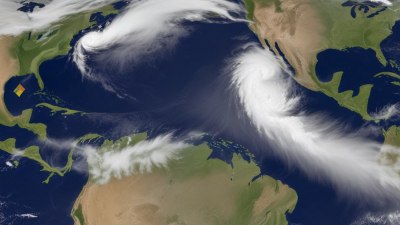What Are Atmospheric Rivers and How They Cause Massive Floods
Learn about atmospheric rivers and their role in causing significant flooding events.

This image was created with the assistance of Freepik
Atmospheric rivers (ARs) are crucial weather phenomena characterized by narrow corridors of concentrated moisture in the atmosphere. These rivers in the sky transport vast amounts of water vapor from tropical regions toward the poles.
They can extend thousands of kilometers in length and can carry moisture equivalent to the flow of the Mississippi River. Although atmospheric rivers are essential for delivering precipitation to various regions, they can also lead to severe flooding, particularly when they release their moisture over land.
What are Atmospheric Rivers?
Atmospheric rivers are long, narrow bands of moisture-laden air that can stretch over a thousand miles. They form when warm maritime air meets colder air from the mid-latitudes. This interaction causes the warm air to rise rapidly, condensing the moisture into clouds and precipitation. Essentially, atmospheric rivers act like highways in the sky, transporting moisture from the ocean to land.
The formation of an atmospheric river begins when wind streams collect warm, moist air over the ocean. When this air moves towards land, it encounters topographical features like mountains which force the air to ascend. As it rises, the air cools, leading to condensation and heavy rainfall. Atmospheric rivers can carry anywhere from 7.5 to 15 times the flow rate of the Mississippi River, significantly impacting regions they encounter.
How do They Cause Massive Floods?
When an atmospheric river makes landfall, it can lead to intense and prolonged rainfall, especially if the air is forced to rise dramatically by mountainous terrain. This upland of moist air can cause significant precipitation, leading to flooding in lower-lying areas. The phenomenon is often exacerbated when multiple ARs impact the same region in quick succession, making saturated soils unable to absorb additional rainfall.
Areas prone to flooding from atmospheric rivers include the West Coast of the United States, particularly California, where the Sierra Nevada mountains play a significant role in amplifying rainfall. When the air masses collide with these mountains, they rapidly cool, resulting in heavy rainfall that can lead to flash floods and mudslides.
The Role of Climate Change
Climate change is influencing the intensity and frequency of atmospheric rivers. Warmer air holds more moisture, which means that ARs may lead to heavier rainfall than in the past. This can result in increased flooding risk, particularly in regions that already face challenges related to water management and infrastructure. Studies indicate that the intensity and duration of atmospheric rivers are expected to increase, leading to more significant impacts on communities and ecosystems.
Moreover, as the climate continues to change, the geographical area affected by atmospheric rivers may expand, putting more populations at risk of flooding. Regions not traditionally accustomed to excessive rainfall could face an uptick in flooding events, disrupting local economies and daily life.
Notable Atmospheric River Events
There have been several notable atmospheric river events that resulted in significant flooding and damage. For instance, the 2017-2018 winter season saw a series of atmospheric rivers hit California, resulting in widespread flooding, landslides, and damage to infrastructure. In addition, the northern U.S. and parts of Canada have also experienced substantial impacts from these weather events.
The 2019 atmospheric river in Northern California, dubbed a 'Pineapple Express' due to its origins near Hawaii, delivered more than a foot of rain in some areas, leading to road closures and evacuation orders. Events like these are becoming more frequent and intense, underscoring the need for improved forecasting and preparedness efforts.
Preparedness and Mitigation
To mitigate the impacts of atmospheric rivers and the flooding they cause, several strategies can be employed. Forecasting technology has advanced significantly, allowing meteorologists to predict AR events and the associated rainfall more accurately. Timely forecasts enable communities to prepare for incoming storms, issue evacuation orders, and allocate resources for emergency management.
Cities can improve their stormwater management systems, investing in infrastructure capable of handling increased rainfall. This includes the construction of detention basins, green roofs, and permeable pavements that absorb rainwater and reduce runoff.
Community Awareness and Education
Community awareness and education play a crucial role in flood preparedness. Informing residents about the risks associated with atmospheric rivers and flooding can empower them to take proactive measures. Local governments can organize workshops, distribute informational materials, and utilize social media to disseminate critical information.
Emergency response teams can benefit from training and simulations to ensure effective responses during atmospheric river events. Collaboration between state agencies, local governments, and emergency services is vital to creating a unified response strategy.
Atmospheric rivers are critical components of the Earth's water cycle and can profoundly affect weather patterns and local ecosystems. While they provide essential moisture for agricultural and water supply, they also pose significant flooding risks, especially in vulnerable areas. Understanding the mechanics of atmospheric rivers and their interactions with climate change is critical for mitigating risks and preparing for future events. Continuous research and investment in infrastructure, preparedness, and community education will be vital in addressing the challenges posed by these powerful weather phenomena.











